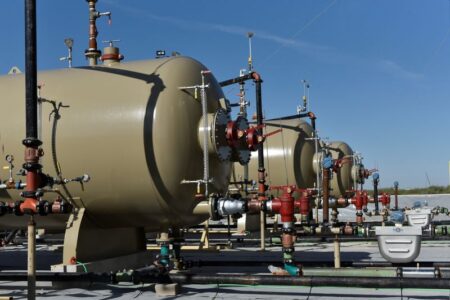Investing.com – The oil rally hit a bump on Wednesday as U.S. oil production hit new three-year highs last week and a weekly reading for crude stockpiles rose for the first time in five weeks as the peak summer driving season drew to a close.
London-traded settled at $91.88 per barrel, down 18 cents, or 0.2%. The global crude benchmark rose to $92.83 earlier in the day, reaching its highest since November 2022.
New York-traded West Texas Intermediate, or , crude settled at $88.52, down 32 cents, or 0.4%. The U.S. crude benchmark hit a 10-month high of $89.64 earlier.
Average daily oil output for last week was estimated at 12.9 million barrels, the the Energy Information Administration, or EIA, said in its Weekly Petroleum Status Report. Until a couple of months ago, crude output from the world’s largest producer of the commodity ranged between 12.1M and 12.2M barrels per day.
Last week’s revision means U.S. oil production is now just 400,000 short of the record high of 13.1M barrels per day averaged in March 2020, just before the coronavirus outbreak which temporarily decimated energy demand.
On the inventory side, U.S. crude oil stockpiles jumped nearly 4M barrels last week and fuel inventories rose by as much or more, indicating lower demand as the summer driving season officially drew to a close.
Specifically, the U.S. was higher by 3.955M barrels during the week ended September 8. Industry analysts tracked by Investing.com had expected a crude drawdown of 2.481M barrels instead for last week to add to the 6.307 million deficit in the prior week to September 1.
On the fuels side, the EIA reported a increase of 5.561M. The forecast consensus was for a gasoline draw of 0.85M barrels that would have added to the prior week’s decline of 2.666M. Automotive fuel gasoline is the No. 1 U.S. fuel product.
With , there was a build of 3.931M barrels versus the expected gain of 1.4M and the prior week’s rise of 0.679M. Distillates are refined into , diesel for trucks, buses, trains and ships and fuel for jets.
Fuel demand collapses
The growth in both crude and fuel supplies coincided with the winding down of summer driving in the United States last week, marked by the Sept. 4 Labor Day holiday. Prior to that, refiners had drawn nearly 20M barrels of crude from inventory over a period of four weeks as they maxed out fuel processing to meet demand. Refiners had maintained an extraordinarily high run rate of more than 93% of their capacity during the period.
As of last week, the EIA said although US refineries were still operating at high run rates, the amount of crude that they turned into fuel was less than before.
“Refineries operated at 93.7% of their operable capacity last week,” the EIA said in its latest Weekly Petroleum Status Report. “Gasoline production decreased last week, averaging 9.2 million barrels per day. Distillate fuel production decreased last week, averaging 5.0 million barrels per day.”
Demand for fuels also fell as the peak summer driving bowed out, the EIA market summary showed. Total gasoline supplied to the marketplace — a key indicator of consumption — fell to a daily average of 8.307M from the prior week’s 9.321M. Gasoline consumption below the daily mark of 9 million is often a red flag for demand, and such usage levels are typical in off-peak periods of demand like now.
Exports of U.S. crude down too, oil Imports up
Alongside domestic demand, exports of U.S. crude — one of the bright spots of the weekly EIA report for months now — fell last week to 3.090M barrels per day from the previous week’s 4.932M.
But imports of crude grew as refiners appeared to pull more oil into the country in anticipation of demand. According to the EIA. U.S. crude imports averaged 7.6 million barrels per day last week, up 0.812M from the prior week. Imports grew despite aggressive supply cuts by Saudi Arabia, which has been trying to channel less crude towards the United States in its bid to skew EIA’s weekly reporting into a more bullish picture for oil.
Joined by the Russians, who announced a 300,000 barrels per day cut from this month, the Saudis’ voluntary reduction of 1.0M barrels daily have had an exaggerated impact on oil prices, sending both Brent and WTI to 10-month highs.
High fuel prices also caused U.S. consumer prices to rise a second month in a row and reach a year-on-year growth of 3.7%, according to Labor Department data on Wednesday that placed renewed pressure on inflation fighters at the Federal Reserve.
U.S. headline inflation, as measured by the , or CPI, hit 40-year highs of more than 9% in June 2022 before falling to as low as 3.0% by June last year. Since then, it has been on the rise, adding a rounded-up 0.7% over the past two months, as high global oil prices bumped up fuel costs at home.
“Over the last 12 months, the all items index increased 3.7 percent before seasonal adjustment,” the Labor Department said in a news release. “The index for gasoline was the largest contributor to the monthly all items increase, accounting for over half of the increase.”
(Ambar Warrick contributed to this item)
Read the full article here












